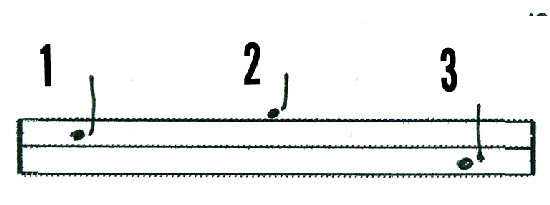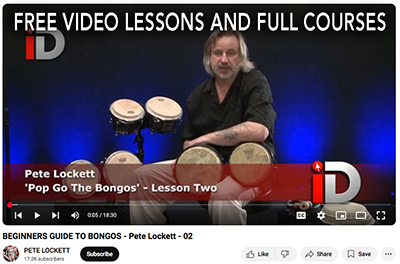|
This page should serve as a good starting
point for anyone interested in getting a little deeper into
conga playing, either for the novice or
someone who has acquired a little experience already. A majority
of the material is for two congas but we do look a little at some
possibilities for three drums. Some
traditional style rhythms and techniques will be looked at, as
well as some alternative techniques
applicable to other musical idioms.
There are three
main drums;
Quinto; Hi Pitched solo drum Conga:
Mid pitched drum Tumba:
Low pitched drum
More specialist companies such as
Remo, LP and Toca
sell a number of different sized congas but it is all to common to see
just two sizes available from many companies. In this instance you
can still make a three drum set by using two of the larger drums tuned
differently. For the sake of this tutorial I am going to refer to
them simply as High, Medium and
Low pitched drums, rather than
Quinto, Tumba etc. When you get into
the realms of three drum set ups, it is really a subjective matter of
what works best for you. (Even more so if you expand to four, five or
six drums!). The layout I have proposed is the way that
suits me best. I am also using manuscript
paper that has been simplified to make the respective drums stand
out clearly. You can download a PDF
of the blank manuscript
HERE or else at the bottom of the page. The layout of
the drums is on three lines with the High pitch drum in the centre, the
Mid pitch drum which is to the players left on the top line and the Low
pitch drum on the players right written on the bottom line. I have
also avoided using complex note heads to make the
transcriptions as transparent as possible.
Key to strokes

1:
Centre drum- High pitch
R =
Right
2:
Drum on players left. Mid pitch
L =
Left
3:
Drum on players right. Low pitch
H
= Heel of hand
T
= Finger tips
S
= Slap stroke
O
=
Open stroke
f
= Flat hand, ghosted /
un-stressed stroke
B =
Bass with flat hand and drum lifted
slightly with feet
*
Any note not marked will be a subtle
touch stroke
The main emphasis here is going to be
with the Cuban style of playing where they
use the
heels and tips of the hands, along with
other full handed strokes and touches in the creation of note
combinations. This style differs from other styles of
Conga playing found in
African and Brazilian
influenced music.
| Basic strokes and Tumbao heel tip
base |
We are going to start with the first part of the
Tumbao rhythm which utilizes the heel tip
technique. The pattern leads with the left hand (for left handed
players you would lead with the right). The first stroke is a left
handed heel stroke articulated by lifting up with the wrist and the
striking the drum head with the underside of the wrist, leaving the
fingers slightly in the air and ready to come down onto the head for the
second stroke. Begin by getting used to this the left hand.
Try it with both hands.
Now we can move on to the
slap stroke. The slap stroke is the sharp cutting sound we often
associate with conga playing. It is one of
those things that you can be shown and practice for months and still
have trouble executing, then one day it just
happens. It is a sort of 'cup the
hand' and 'grab' type motion.
After you have struck the head you leave the finger tips on the head and
grab slightly, like you were pulling some string in towards yourself.
It is not a stroke that necessarily needs to be articulated violently,
even though it sounds accented and aggressive. It is a
knack and if you try for long enough you
will get it, believe me. It's not rocket science!
Now we will combine these strokes for the basis of our
Tumbao pattern.
The sequence is; HEEL-TIP SLAP-TIP
AUDIO


Heel tip pattern
| Basic Tumbao
for one drum |
Now all we need to do is add a couple of open notes
into the technique to have the basic Tumbao
for the Conga. You do not leave you hand on the head after you have
struck the drum like you do for the slap stroke. For this stroke
you want the drum to resonate. The hand at
the bass of the fingers is roughly on the edge of the drum when this
stroke is articulated. To far back out towards yourself and you
will get a thinner and less rounded open tone.
The sequence is; HEEL-TIP
SLAP-TIP-HEEL-TIP-OPEN-OPEN
AUDIO


First part of tumbao
| Basic Tumbao
for two drums |
Now we can look at a slightly more developed version
of the Tumbao for two drums. This will
involve two open tones being played on the Lower pitched
conga placed to our right.
AUDIO


Tumbao on two drums. Click to enlarge
| Basic Tumbao
for one drum |
Originally this would have been played on
one drum with the open bass notes on the
lower drum articulated by lifting the conga
from the floor with our heels and playing accented bass notes with the
flat hand in the centre of the drum.
These are not anything like the open tone, with the hand striking the
centre of the drum firmly and staying on the skin for a milli-second
afterwards.
AUDIO


Tumbao on one drum. Click to enlarge
Check out some of these simple
Tumbao variations.
AUDIO

| Basic Son Montuno
for two drums |
Combine all these techniques over four bars and we
have the basic Son Montuno for two drums.
AUDIO


Son Montuno. Source, Giovanni Hidalgo.
Click to enlarge
| Basic Son Montuno
leading with the left |
I prefer leading with the right hand to articulate
this Son Montuno for two drums. It is
important to work on all the strokes for both hands, heel, tip, slap,
bass tone etc.
AUDIO


Standard 2:3 clave pattern found in Cuban
styles. Click to enlarge
This is a great rhythm for
Congas, one of my faves. Here is the basic pattern.
AUDIO


Rhumba pattern for two congas. Click
to enlarge
It is easy if you strip down the basis of
the pattern to this hand pattern.

Basic hand pattern for Rhumba. Click
to enlarge
|
Rhumba with accompaniment |
Here is what it might sound like with a few of the
other percussion parts of the ensemble.
AUDIO


2:3 Rhumba clave pattern.
Click to enlarge

2:3 cowbell pattern. Click to
enlarge
I have come across lots of versions of
Mozambique on my musical travels. I
like to use it as a basis for a lot of
non-traditional patterns as it really has a great feel over four
bars. The 'percussive melody' between the two drums is really great.
AUDIO


Variation on Mozambique pattern for two
congas. Click to enlarge
This version is a slightly more
traditional execution, incorporating the heel tip strokes. This
would be to the 2:3 Rhumba clave.

Mozambique pattern for two congas. .
Click to enlarge
| Bongo Martillo
for Congas |
This is something that I am sure must be commonly
employed, although I have never seen anyone do it personally.
It is a simple manipulation of the
Bongo Martillo pattern onto
Congas. Apparemtly, this is a rhythm
known as "caballo" It used to be common in
the pachanga rhythm and today it is often
used in fast merengues. There is also a
variation called "pambichao" Lovely
stuff! 'HEEL-TIPS'
at the ready.
AUDIO


Bongo Martillo adapted onto congas.
Click to enlarge
| Pop patterns 1 & 2 for Congas |
The pop applications employ a more
African/Brazilian approach to the
instrument where articulated predominantly with
'R-L-R-L' hand to hand stroke combinations with very little
'heel-tip' utilization. This technique is to be by no means
underestimated and can yeald some truly fantastic patterns. All the
notes in these patterns without an indication regarding heel, tip or
open should be played as light touches on the conga.
AUDIO


Pop conga pattern 1. Click to enlarge

Pop conga pattern 2. Click to
enlarge
AUDIO


Pop conga pattern 3. Click to enlarge
AUDIO


Pop conga pattern 4. Click to
enlarge
AUDIO


Pop conga pattern 5. Click to
enlarge


 |
